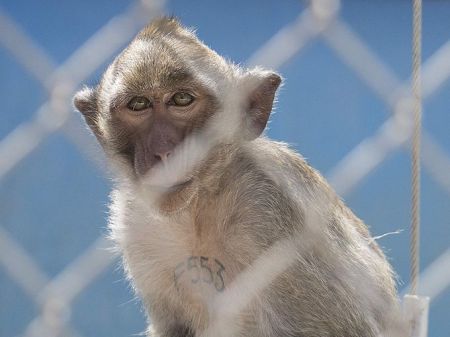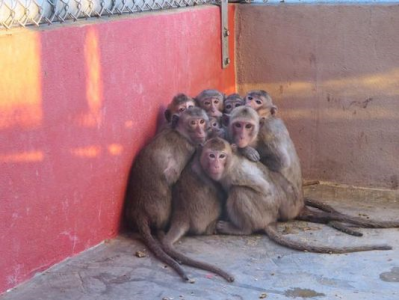No one talks much about “Monkey Island” anymore. For a long time Key Lois was getting eaten alive by a colony of rhesus macaques that were living large before shipping out to medical labs. Catered meals. Lush red mangroves. Sex. What could be better? Probably the Everglades, primate experts say.
In nearby Hendry County the lid is off a secretive monkey trade that is worrying long-time residents, eco-stewards, and animal activists. Four controversial facilities house more than 10,000 monkeys, mainly rhesus macaques. That’s roughly one monkey for every four Hendry residents and business is growing.
“No doubt they could adapt,” said Fred Bercovitch of the Primate Research Institute in Kyoto, Japan. “In India they also regularly invade croplands and farms and no doubt they’d do the same in Florida.”

Primate Products was flagged for eight violations of the federal Animal Welfare Act, the Fort Myers News-Press reported. (Via News-Press / Andrew West)
Hendry County’s so-called monkey farms involve enclosures. But residents are raising security concerns and wonder what might happen, say, when the next hurricane hits.
"Thriving and multiplying" in Puerto Rico
In 2012 Puerto Rico reportedly had enough of the monkey trade and blocked Bioculture, a monkey farm that recently took its business to Hendry.
“A free-ranging rhesus population on La Parguera [Island] was originally used for behavioral study and breeding but several individuals escaped to the mainland of Puerto Rico,” said Carol Berman, an anthropologist at the University of Buffalo. “Their descendants have been thriving and multiplying there since the 1970s.”
The Monkey Island monkeys gorged on rich mangrove shorelines, which also threatened homes for birds and marine life. The islands were shrinking in the 1990s, according to Department of Environmental Protection. The DEP said Key Lois was potentially in danger of washing away in a big storm.
After eco-stewards battled for years to avert an environmental disaster, the grim notion of every monkey for himself in a hurricane was too much to picture. Gov. Lawton Chiles and a Cabinet order put the kibosh on Monkey Island in 1997.
“It is not unrealistic to suppose that rhesus would be able to survive, perhaps thrive, in the Everglades,” said Rodney L. Johnson, an anthropologist and international primate authority who studied Monkey Island in the ’80s.
"An escaped troop would cause problems"
Hendry County stakeholders are leading a nationwide chorus raising human safety and environmental concerns.
“To me as a conservation biologist,” Bercovitch said in an email, “the main problem is that, like the Burmese pythons, [monkeys] would be an invasive species with the potential to disrupt the natural ecosystem and possibly endanger the endemic wildlife. … An escaped troop would cause problems.”
Johnson said he was unable be specific about his experience on Key Lois and Raccoon Key “for a variety of reasons.”
In an email, he said, “Let me point out that rhesus are native to the Sundarbans of India, a habitat very similar to the Everglades, one that includes tigers as well as predatory snakes. … Rhesus are the most widely distributed nonhuman primate in the world.”
A feral monkey troop has deep roots in Silver Springs State Park, possibly dating to the 1930s after an accidental release. In recent years monkey sightings range from Putnam County north of Ocala to as far south as Osceola County, according to the state Fish and Wildlife Conservation Commission. There's also the heralded Mystery Monkey of Tampa Bay and a similar freedom fighter that caused a sensation last Thanksgiving.
Southwest Florida residents, statewide activists, and national animal welfare groups are applying pressure on Hendry County, state, and federal officials through highly publicized protests and lawsuits. An ongoing series of reports by The Fort Myers News-Press has focused worldwide attention on what is being called the monkey breeding capital of the U.S.
No shortage of predators
“Predation from pythons, panthers, alligators, etc. would take a toll on them but I see no reason why macaques could not persist in the Everglades,” said Sarah Blaffer Hrdy, a California-based anthropologist. “They do quite well in the mangrove swamp areas surrounding La Parguera Island.
“[But] I’m not sure that an [accidental] population of rhesus macaques … would be any worse than various water management practices and other human factors already impacting the Everglades.”

An animal rights group went undercover at a Hendry County monkey farm that sparked a federal investigation. (Via PETA)
Primate Products (640 acres), Mannheimer Foundation (200), Primera (34), and Bioculture (4) pay taxes on more than 875 acres in a community that is proud of its agriculture tradition.
“Is this really what Hendry County wants to be known for,” a 67-year-old Alva woman said at a March rally.
Primate Products is the focus of a zoning complaint, according to The News-Press. A lawsuit also alleges Hendry approved Primera, the newest facility, without public input.
Eight violations of Animal Welfare Act
The People for the Ethical Treatment of Animals filed a graphic online report based on an undercover video at Primate Products of Immokalee. An official complaint by PETA sparked a federal investigation in May. The U.S. Department of Agriculture flagged Primate Products with eight violations of the Animal Welfare Act involving inhumane conditions.
The violations included a security breach in 2014, when a bear scaled a fence and busted into an enclosure, mauling two monkeys.
“There hasn't been an escape in three years,” Thomas Rowell, head of Primate Products, told Amy Bennett Williams of The News-Press. “Typically, if [a monkey] does get out beyond the confines of the cage, rarely — and I mean rarely — do they ever leave. They're comfortable with the wire.”
Bercovitch said Rowell was right about that.
“Sometimes when monkeys do escape from a zoo or enclosure they hang around the enclosure rather than run off into the wilds because their friends and families are still inside the fence,” Bercovitch said.
» Homepage photo, Primate Products facility, via Fort Myers News-Press
 » 2014: Mystery Monkey II? Apparently he's still out there.
» 2014: Mystery Monkey II? Apparently he's still out there.
Outside
Bitcoin mining emissions in China will hit 130 million tonnes by 2024 https://t.co/w6He7so8N2 pic.twitter.com/qYUDtBdeRK
— New Scientist (@newscientist) April 9, 2021
The Gunk Report
For the Blue-Green Algal Bloom Weekly Update from the Florida Department of Environmental Protection, tap here. For DEP's Algal Bloom Sampling Map, tap here.
What, me worry?
» "PLAYING WITH SHARKS," which recently premiered at the Sundance Film Festival, documents diving legend Valerie Taylor.